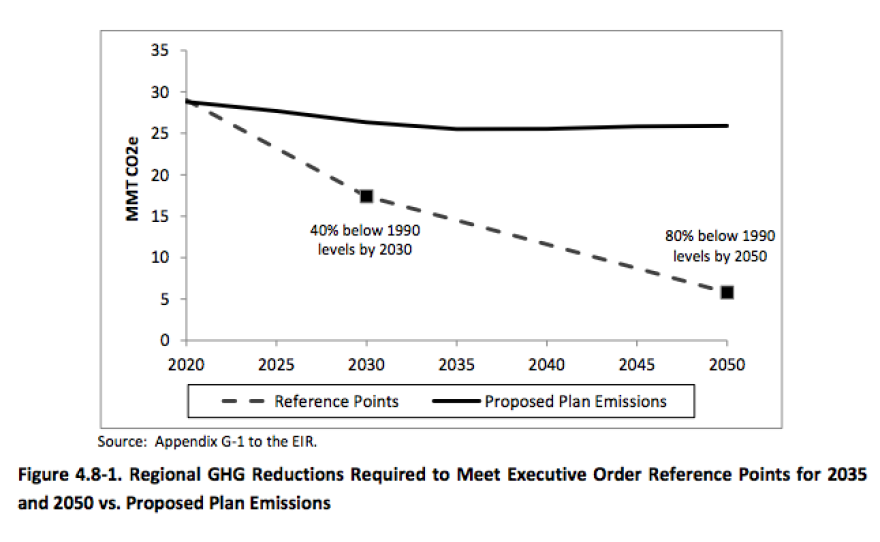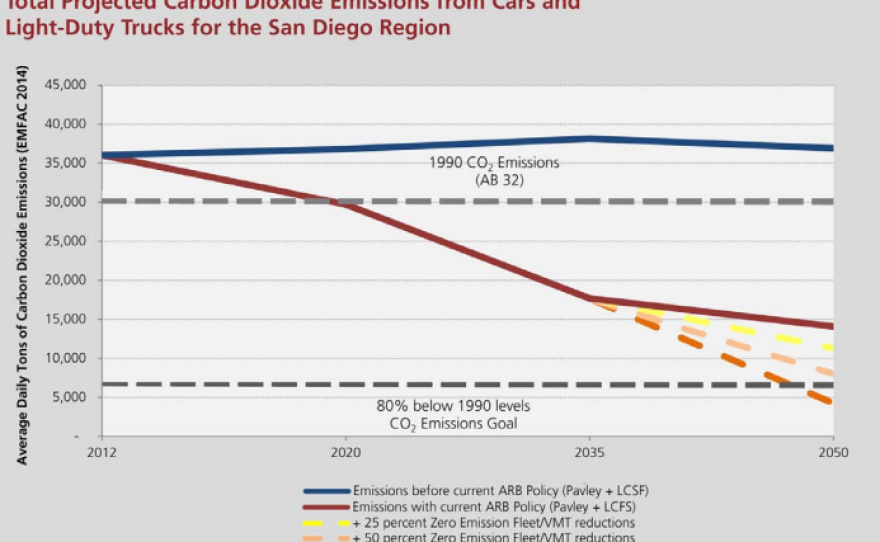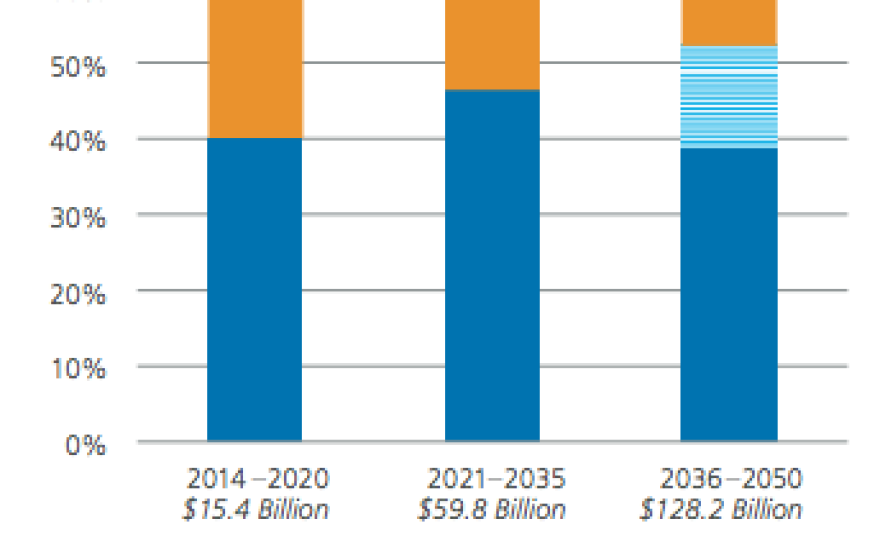Just before San Diego County's regional planning agency closes public comment on its transportation plan on Wednesday, a dispute has arisen over whether it would cut enough greenhouse gas emissions to meet state-mandated standards.
The region’s emissions will only dip slightly and then level off in the next 34 years, according to the plan drafted by the San Diego Association of Governments. That’s not enough to satisfy state law.
Environmental groups say SANDAG is responsible for creating a plan that cuts emissions 80 percent by 2050 — a target Gov. Jerry Brown set with executive orders. SANDAG projections show emissions will only dip by about 10 percent between 2020 and 2050, and will actually increase slightly between 2035 and 2050.

SANDAG hasn’t made these projections easy to find.
They aren’t in the agency’s draft regional transportation plan, a glossy 173-page plan filled with photos and charts that was released in April and will be voted on this fall. They also weren’t presented to the public in a series of hearings in May. Instead, a graphic in SANDAG’s plan shows it not only meets but exceeds carbon dioxide emission goals.

That’s because the chart SANDAG presents to the public only shows emissions from cars and small trucks, which meet state standards. But the projections that show the full picture indicate the plan won't come anywhere near meeting the state requirements. Those projections are only included in an environmental impact report of the plan, a dense nine-chapter document posted on the agency’s website.
“Instead of making it known to the public that this transportation plan is not going to protect our quality of life or our public health in the long term, they’re instead kind of glossing over that and pretending they’re not responsible for it,” said Nicole Capretz, head of the San Diego environmental group Climate Action Campaign.
Comment On The Plan
You can comment on SANDAG's transportation plan here. Comments will be accepted until Wednesday.
SANDAG only included car and truck emissions in its plan because that’s all it is responsible for, said Charles “Muggs” Stoll, the agency’s director of land use and transportation planning.
“The state of California gives us targets based on what we have the ability to control and or influence,” Stoll said.
Different kinds of emissions
Carbon dioxide is produced from a variety of sources, including solid waste, natural gas and electricity generation. But Stoll said SANDAG can only influence how far people drive and whether they have other options for transit besides cars, not the other emissions sources.
“It’s going to take a lot from a lot of different sectors of the economy to be able to achieve the ultimate executive order goals,” he said. “Like improving vehicle fuels and types of vehicles and a lot of technological advancements to be able to get to that goal. But we are doing our part by providing choice and opportunities and alternatives to driving alone in our region.”
Stoll contends that SANDAG is not required to meet the 80 percent reduction in the greenhouse gas emission target set by Brown's executive orders. He said SANDAG only must answer to a separate law that lays out specific smaller targets for car and truck emissions for planning agencies like SANDAG. That law says SANDAG has to cut car and truck emissions by 13 percent by 2035.
The agency's plan meets that goal, cutting car and truck emissions by 24 percent by 2035.
In written answers to questions from KPBS, SANDAG officials said that they do not yet know what the target for 2050 will be.
“Even the state doesn’t know how it will ‘comply’ with the goals it has set for itself in the Executive Orders,” the officials said. “The governor is setting goals for the state, and then later will try to figure out IF and HOW the goals will be met.”
More: Read SANDAG's responses to questions from KPBS about its transportation plan.
It’s an argument SANDAG has made before. Its 2011 transportation plan also met state targets for car and truck emissions but did not meet the overall carbon dioxide reduction target. A coalition of environmental groups sued SANDAG for not creating a plan that meets the larger target, and the San Diego County Superior Court agreed with the environmentalists.
In his ruling, the judge wrote that the plan’s failure “to cogently address the inconsistency between the dramatic increase in overall (greenhouse gas) emissions after 2020 contemplated by the (regional transportation plan) and the statewide policy of reducing same during the same three decades (2020 to 2050) constitutes a legally defective failure” to provide decision makers and the public with enough information about the environmental impacts of its plan.
A state appeals court upheld that ruling, but SANDAG appealed to California’s Supreme Court, which will decide the case sometime this year.
Jana Clark with the Cleveland National Forest Foundation, one of the nonprofit environmental groups that sued over the 2011 plan, said SANDAG is responsible for much more than just how far and often people drive.
“SANDAG has a hand in all of the other greenhouse gas emissions, because SANDAG’s regional transportation plan is literally the blueprint for how we grow,” Clark said. “It will shape future growth. It will shape future land use. It will shape future emissions.”
SANDAG disagreed in its written answers.
“The arguments in litigation have been about how much SANDAG has to analyze and disclose with regard to its plans and the Executive Orders in order to comply with the California Environmental Quality Act,” it said.
Old plan, new plan
While SANDAG’s 2011 plan is held up in litigation, the agency is still required to update its plan every four years. Clark said instead of doing more to reduce the region’s greenhouse gas emissions, “the 2015 plan is pretty much the same as the old one.”
“All the same roadway and freeway projects that were part of the failed 2011 plan are still there,” Clark said.

SANDAG maintains its plan spends heavily on public transportation, with up to 45 percent of its expenditures in the next 34 years going to transit. However, about half of that spending will be on maintaining current transit systems, not building new projects. Around 1 percent of its funding will go toward bike lanes and other bike projects, while 42 percent will go to roads and highways.
San Diego Mayor Kevin Faulconer sits on SANDAG’s board. When asked whether he supports the 2015 transportation plan, his spokesman sent a one-sentence statement: “The Mayor is currently evaluating the proposal.”
San Diego City Councilman Todd Gloria also sits on SANDAG’s board and said he supports the 2015 transportation plan. He said SANDAG has to balance the interests of all the areas it represents — from North County, where freeway congestion is an issue, to the city of San Diego, where some residents want more biking and public transit.
Gloria said SANDAG’s plan does enough to increase biking and transit “within the scope of our jurisdiction, our abilities, our funding.”
“When I speak with advocates on this subject, I feel as though they expect the whole of our climate change initiative to be borne by SANDAG, and that’s not a reasonable expectation,” he said.
Gloria agreed with SANDAG that the agency is only responsible for reducing emissions from cars and small trucks.
“SANDAG doesn’t regulate our utilities, we don’t source energy,” he said. Instead, he said, cities like San Diego can create climate action plans that rely on renewable energy to reduce emissions.
“But that’s not a role SANDAG has,” Gloria said. “When you look at the targets that are envisioned, they have to be in context of what we have control over, which is only a piece of it. Admittedly, a large piece, but not the entire pie.”
But in the ruling against the 2011 plan, the Superior Court judge said SANDAG’s stance that it’s up to local jurisdictions to reduce greenhouse gases enough to meet state targets is "kicking the can down the road," “perverts the regional planning function of SANDAG” and “ignores the purse string control SANDAG has” over a half-cent sales tax for local transportation projects.

New targets coming
If the state Supreme Court finds that SANDAG is right, that it only has to worry about car and small truck emissions, the planning agency still could soon have another target to meet.
The state Senate recently passed a set of bills that could set tougher emission reduction targets for SANDAG and other agencies. If they become law, they would take effect Jan. 1.
Stoll said SANDAG’s plan will pass before those laws would take effect, so it wouldn’t need to meet those new targets until its next plan update in 2019.
“If that legislation were to pass, we’d have to first of all understand what it is,” Stoll said. “Our understanding is the California Air Resources Board would probably have to follow up and give either guidance or possibly even set new targets based on it.”
SANDAG’s written answers added that “assuming the bill passes and new targets are eventually set, they will be incorporated into the next RTP update.”
Capretz with the Climate Action Campaign said SANDAG shouldn’t wait until it’s forced to change its plans.
“We have to think beyond what the nuts and bolts of the legal mandates are, and instead we should be doing what’s right for the future quality of life in San Diego,” she said.
SANDAG is accepting public comment on its plan until Wednesday. Its board will vote on the plan this fall.






